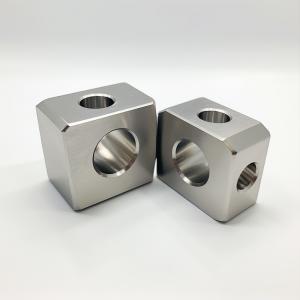

Add to Cart
CNC milling is a manufacturing technique that employs rotating cutting tools to selectively remove
material from a workpiece, shaping it into finished parts and products.
This versatile process is well-suited for a wide range of materials, spanning metals, polymers, wood,
and glass. Typically, CNC milling systems feature 3 linear degrees of freedom—encompassing the X,
Y, and Z axis—yielding exceptional precision and intricate detailing.
Additionally, We offers more advanced 5-degree systems, incorporating tool head and machining
bed rotation (A and B axes). This advanced capability enables 5-axis CNC machines to craft complex
geometric parts without the need for multiple machine setups.
Product Details
CNC machining machines exhibit the capability to cut a diverse range of materials, including
aluminum, bronze, copper, ceramics, plywood, various steel alloys, stone, wood, zinc, and other
engineering materials.
This versatility makes CNC machining an ideal choice for generating prototypes in product
development. It enables precise and rapid adjustments until achieving the desired end product.
| Common Materials for CNC Machining | |
| Material | Properties |
| Aluminum | 2024: Good fatigue resistance and strength; excellent toughness at moderate to high strength levels; improved fracture toughness |
| 6061: Excellent machinability, low cost, and versatility | |
| 7075: High strength, hardness, low weight, and heat tolerance | |
| Brass | Versatile and highly attractive copper/zinc alloy with warm yellow color accommodates severe forming/drawing |
| Copper | High ductility and high electrical and thermal conductivity; develops attractive blue-green surface patina over time |
| Stainless Steel | Excellent machinability and outstanding uniformity; good workability and weldability, high ductility and formability |
| Steel Alloy | Mix of chromium, molybdenum, and manganese yields toughness, good torsional and fatigue strength |
| Steel Mild Low Carbon | High machinability and weldability, high stiffness; good mechanical properties, machinability, and weldability at low cost |
| Titanium | Excellent strength to weight ratio, used in aerospace, automotive, and medical industries |
| ABS | Excellent impact resistance, good mechanical properties, susceptible to solvents |
| Nylon | Excellent mechanical properties, high toughness, poor moisture resistance |
| POM | High stiffness, excellent thermal & electrical properties, relatively brittle |
| CNC Milling Tolerances | ||
| Limits for nominal size | Plastics | Metals |
| 0.5mm* to 3mm | ±0.1mm | ±0.05mm |
| Over 3mm to 6mm | ±0.1mm | ±0.05mm |
| Over 6mm to 30mm | ±0.2mm | ±0.10mm |
| Over 30mm to 120mm | ±0.3mm | ±0.15mm |
| Over 120mm to 400mm | ±0.5mm | ±0.20mm |
| Over 400mm to 1000mm | ±0.8mm | ±0.30mm |
| Over 1000mm to 2000mm | ±1.2mm | ±0.50mm |
| Over 2000mm to 4000mm | ±2.0mm | |
*Please clearly indicate tolerances for nominal sizes below 0.5mm on your technical drawing. | ||
CNC Machining Applications
1. Medical:
Precision is paramount in the medical industry, and CNC machining
is widely employed to
manufacture intricate components for medical devices and equipment.
2. Electronics:
The electronics industry benefits from CNC machining for the
production of precise components
used in electronic devices, ensuring the functionality and reliability of the end products.
3. Defense:
The defense sector utilizes CNC machining for the production of
accurate and durable components
used in military applications, ensuring the reliability and performance of defense systems.
4. General Manufacturing:
CNC machining is widely adopted in general manufacturing,
contributing to the production of a
broad range of components used in various applications across industries.
CNC machining's versatility, precision, and efficiency make it a crucial manufacturing process in these
industries, contributing to the production of high-quality components essential for diverse applications.
Company Profile
FAQ's
1. What are the advantages of CNC machining?
1. Rapid Prototyping: CNC machining excels in rapid prototyping, facilitating quick iterations and
testing of designs.
2. Efficient Production: The ability to produce full-scale
production parts rapidly contributes to the
efficiency of CNC machining.
3. Precision and Accuracy: CNC machining ensures a high level of
precision and accuracy in
manufacturing, meeting tight tolerances for CNC parts of varying sizes.
4. Tight Tolerance Machining: CNC machining allows for tight
tolerance machining, ensuring
consistent adherence to exact specifications.
5. Flexibility: CNC machining offers flexibility across production
volume, pricing, lead times,
and the choice of materials and finishes, providing a versatile solution for manufacturing needs.
2. What are standard machining tolerances?
The standard machining tolerance is ± 0.005" or 0.13mm. Tolerances represent the allowable range
for a dimension. For example, if a CNC machining tool has a tolerance of ± 0.01 mm, it means the
tool can deviate by 0.01 mm in each cut.
Utilizing a drawing, our CNC machining service can achieve CNC parts with tolerances as low as
± 0.0002 in. In the absence of a drawing, all CNC parts adhere to our ISO 2768 medium standard.
Additionally, we have the capability to machine to tighter tolerances, such as ±0.025mm or ±0.001",
when an engineering drawing specifies critical features.
3. What size of fillets are added when no specific fillet is specified by the 3D model or drawing?
When a specific fillet radius is not specified in the 3D model or drawing, fillet radii conducive to easy
machining will be added at the machinist's discretion.
For guidance, internal vertical edge radii could exceed 1/3 of the depth, while internal horizontal edges
may either be left sharp or have a radius ranging from 0.5mm to 1mm.
